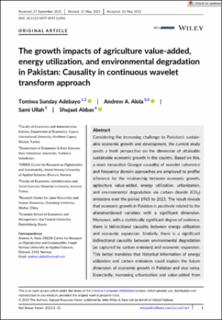| dc.contributor.author | Adebayo, Tomiwa Sunday | |
| dc.contributor.author | Alola, Andrew Adewale | |
| dc.contributor.author | Ullah, Sami | |
| dc.contributor.author | Abbas, Shujaat | |
| dc.coverage.spatial | Pakistan | en_US |
| dc.date.accessioned | 2023-09-20T07:28:36Z | |
| dc.date.available | 2023-09-20T07:28:36Z | |
| dc.date.created | 2023-07-10T14:44:52Z | |
| dc.date.issued | 2023 | |
| dc.identifier.citation | Natural resources forum (Print). 2023, . | en_US |
| dc.identifier.issn | 0165-0203 | |
| dc.identifier.uri | https://hdl.handle.net/11250/3090652 | |
| dc.description.abstract | Considering the increasing challenge to Pakistan's sustain-able economic growth and development, the current studyposits a fresh perspective on the dimension of attainablesustainable economic growth in the country. Based on this,a more innovative Granger causality of wavelet coherenceand frequency domain approaches are employed to profferinference for the relationship between economic growth,agriculture value-added, energy utilization, urbanization,and environmental degradation via carbon dioxide (CO2) emissions over the period 1965 to 2021. The result revealsthat economic growth in Pakistan is positively related to theaforementioned variables with a significant dimension.Moreover, with a statistically significant degree of evidence,there is bidirectional causality between energy utilizationand economic expansion. Similarly, there is a significantbidirectional causality between environmental degradation(as captured by carbon emission) and economic expansion.This better translates that historical information of energyutilization and carbon emissions could explain the futuredimension of economic growth in Pakistan and vice versa.Expectedly, increasing urbanization and value-added fromthe agricultural sector of the economy both Granger causeseconomic growth in Pakistan. The implication for thepolicymaker is that as much as economic growth is a vitalindicator of sustainable development, the policy initiativesshould reflect environmental, energy development, agricul-tural sector, and urban activities dimensions. | en_US |
| dc.language.iso | eng | en_US |
| dc.rights | Navngivelse 4.0 Internasjonal | * |
| dc.rights.uri | http://creativecommons.org/licenses/by/4.0/deed.no | * |
| dc.subject | agricultural activities | en_US |
| dc.subject | economic growth | en_US |
| dc.subject | energy usage | en_US |
| dc.subject | environmental factor | en_US |
| dc.subject | Pakistan | en_US |
| dc.title | The growth impacts of agriculture value-added, energy utilization, and environmental degradation in Pakistan: Causality in continuous wavelet transform approach | en_US |
| dc.type | Peer reviewed | en_US |
| dc.type | Journal article | en_US |
| dc.description.version | publishedVersion | en_US |
| dc.rights.holder | © 2023 The Authors | en_US |
| dc.subject.nsi | VDP::Samfunnsvitenskap: 200::Økonomi: 210 | en_US |
| dc.source.pagenumber | 21 | en_US |
| dc.source.journal | Natural resources forum (Print) | en_US |
| dc.identifier.doi | 10.1111/1477-8947.12306 | |
| dc.identifier.cristin | 2161723 | |
| cristin.ispublished | true | |
| cristin.fulltext | original | |
| cristin.qualitycode | 1 | |

